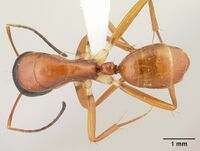Camponotus lamosy
| Camponotus lamosy | |
|---|---|

| |
| Scientific classification | |
| Kingdom: | Animalia |
| Phylum: | Arthropoda |
| Class: | Insecta |
| Order: | Hymenoptera |
| Family: | Formicidae |
| Subfamily: | Formicinae |
| Tribe: | Camponotini |
| Genus: | Camponotus |
| Subgenus: | Mayria |
| Species: | C. lamosy |
| Binomial name | |
| Camponotus lamosy Rakotonirina & Fisher, 2018 | |
Camponotus lamosy occupies the littoral forest habitats of the north, the rainforests of the northeast, and the montane rainforests of the central high plateau and the southeast of Madagascar. Endemic to the island, the species is found foraging both on the ground and through the leaf litter or on the lower portions of vegetation, and its nests are located in rotten logs or in dead branches above ground.
Identification
A member of the subgenus Mayria (see diagnosis). Rakotonirina and Fisher (2018) - Clypeus without median longitudinal carina; mandible with six teeth; anteromedian margin of clypeus not lamellate; in lateral view, mesosoma short and high, its dorsal outline continuously arched in a domelike structure; propodeal declivity inclined posteriorly; in lateral view, propodeal dorsum slightly excised medially, petiolar node longer than high.
Camponotus lamosy is similar to Camponotus dromedarius and Camponotus pulcher, but can be distinguished by its slightly excised propodeal dorsum.
Keys including this Species
Distribution
Latitudinal Distribution Pattern
Latitudinal Range: -12.28617° to -23.4635°.
| North Temperate |
North Subtropical |
Tropical | South Subtropical |
South Temperate |
- Source: AntMaps
Distribution based on Regional Taxon Lists
Malagasy Region: Madagascar (type locality).
Distribution based on AntMaps
Distribution based on AntWeb specimens
Check data from AntWeb
Countries Occupied
| Number of countries occupied by this species based on AntWiki Regional Taxon Lists. In general, fewer countries occupied indicates a narrower range, while more countries indicates a more widespread species. |

|
Estimated Abundance
| Relative abundance based on number of AntMaps records per species (this species within the purple bar). Fewer records (to the left) indicates a less abundant/encountered species while more records (to the right) indicates more abundant/encountered species. |

|
Biology
Castes
Worker
Minor
   
| |
| . | |
Nomenclature
The following information is derived from Barry Bolton's Online Catalogue of the Ants of the World.
- lamosy. Camponotus lamosy Rakotonirina & Fisher, 2018: 32, figs. 2B, 10A, 18, 24 (s.w.) MADAGASCAR.
- Type-material: holotype worker, 11 paratype workers.
- Type-locality: holotype Madagascar: Antsiranana, PN Montagne d’Ambre, 3.6 km. 235° SW Joffreville, -12.53444, 49.1795, 925 m., transect sample #08, Beatb 25 sample transect, 20 m., 20-26.i.2001, BLF02566 (B.L. Fisher, C.E. Griswold, et al.); paratypes with same data.
- Type-depositories: CASC (holotype); BMNH, CASC, MHNG, PBZT (paratypes).
- Combination in C. (Myrmonesites): Rakotonirina & Fisher, 2018: 32.
- Distribution: Madagascar.
Unless otherwise noted the text for the remainder of this section is reported from the publication that includes the original description.
Description
Worker
Minor. In full-face view head longer than broad (CWb/CL: 0.77±0.03; 0.73–0.82), lateral margins roughly straight and slightly converging anteriorly and posteriorly; posterior margin more or less straight. Clypeus with straight anteromedian margin and rounded anterolateral angle. Eyes sometimes breaking the lateral outlines of the head, their posterior margins located well behind the mid-length of the head (PoOc/CL: 0.34±0.01; 0.31–0.37). Mandible triangular, apical margin with six sharp teeth. Antennal scape long, roughly its apical third surpassing posterior margin of head. In lateral view, outline of pronotum more or less straight and mesonotum forming a separate convexity; propodeum slightly concave anteriorly and weakly convex posteriorly; its junction to declivity angulate; declivity inclined posteriorly. Petiolar node longer than high.
Dorsum of head and gastral segments with abundant erect filiform hairs; pronotum with 2 pairs, mesonotum, propodeum and petiolar node with one pair of erect hairs. Pubescence short and sparse on gastral segments. Head black, mesosoma, petiolar node, gaster and legs yellow-orange with black to dark brown spot on lower level of lateral surface of pronotum, propodeum and petiole. Coxa and trochanter whitish-yellow, base and apical portion of femur dark brown.
Major. Differing from minor worker in having larger heart-shaped head, apical fourth of antennal scape surpassing posterior cephalic margin; robust mesosoma with distinct metanotum, and as high as long petiolar node. Other characters as in minor worker.
Type Material
Holotype worker. Madagascar: Province Antsiranana, Parc National Montagne d'Ambre, 3.6 km 235° SW Joffreville, -12.53444, 49.1795, 925 m, transect subsample #08, Beat 25 sample transect, 10 m, beating low vegetation montane rainforest, 20–26 Jan 2001 (Fisher, Griswold et al.) collection code: BLF02566, specimen code: CASENT0408976 (California Academy of Sciences).
Paratypes. 11 workers with same data as holotype but with specimen codes: CASENT0408963, CASENT0408965, CASENT0408966, CASENT0408968, CASENT0408970, CASENT0408971, CASENT0408972, CASENT0408973, CASENT0408974, CASENT0408975, CASENT0408977 (CASC, The Natural History Museum, Musee d'Histoire Naturelle Genève, Parc Botanique et Zoologique de Tsimbazaza).
References
- Rakotonirina, J.C., Fisher, B.L. 2018. Taxonomic revision of the Malagasy Camponotus subgenus Mayria (Hymenoptera, Formicidae) using qualitative and quantitative morphology. Zootaxa 4438: 1–58 (doi:10.11646/zootaxa.4438.1.1).
- Rasoamanana, N., Fisher, B.L. 2022. A taxonomic revision of the Malagasy endemic subgenus Mayria of the genus Camponotus (Hymenoptera, Formicidae) based on qualitative morphology and quantitative morphometric analyses. ZooKeys 1081: 137–231 (doi:10.3897/zookeys.1081.71872).

